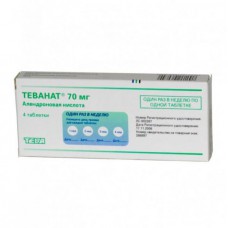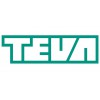Expiration date: 11/2026
The composition and form of issue:
Tablets. 1 tablet contains:
active substance:
sodium alendronate monohydrate 11.6 mg
(equivalent to 10 mg alendronova acid)
excipients: hydroxypropyl cellulose nizkosoleva hydroxypropyl cellulose silicon dioxide colloidal sodium fumarate stearyl
active substance:
sodium alendronate monohydrate 81,2 mg
(corresponds to 70 mg alendronova acid)
excipients: microcrystalline cellulose sodium croscarmellose magnesium stearate
blistere in 10 PCs. in cartons of 3 blister packs (tablets 10 mg), or blistere 4 PCs the paper cartons 1, or 3 blisters (tablets 70 mg).
Description pharmaceutical form:
Tablets 10 mg: white or almost white, lenticular, without risks.
Tablets 70 mg: white or almost white, flat, bevelled, round, with engraving "T" on one side and smooth on the other.
Pharmacokinetics:
The bioavailability of alendronova acid in the dose of 5-70 mg when administered on an empty stomach directly 2 hours before Breakfast is in women of 0.64% and 0.6% in men. When taken on an empty stomach 1-1. 5 hours before Breakfast the bioavailability of the drug is reduced by 40%. After drinking coffee and orange juice reduced bioavailability by approximately 60%.
Communication alendronova acid with proteins of serum of blood is about 78%. The drug is distributed in soft tissue, and then rapidly redistributed to bone, where it is latched or excreted in the urine. The concentration of the drug in blood plasma after oral therapeutic dose is below the limit of measurement (<5 ng/ml).
Not biotransformation.
Excretion of the drug is in unchanged form and is characterized by a rapid decline of drug concentration in plasma and extremely slow release from the bones. The final T1/2 is over 10 years, reflecting the release of the drug from bone tissue.
Description pharmacological action:
Tevanate is a drug from the group aminobisphosphonates — synthetic analogues of pyrophosphate, bind to hydroxyapatite within the bone tissue. Increases bone mineral density of the spine and other bones of the skeleton. Antiresorptive mechanism of action is associated with suppression of osteoclast function. Promotes the formation of bone tissue with normal histological structure.
Indications:
- treatment of postmenopausal osteoporosis
- the osteoporosis caused by the use of glucocorticosteroid drugs.
Contraindications:
- hypersensitivity to any component of the drug
- hypocalcemia
- stricture or achalasia of the oesophagus and other conditions leading to slower movement of food through the esophagus
- the inability of the patient to stand or sit upright for at least 30 min.
- severe renal insufficiency (Cl creatinine less than 35 ml/min)
- severe disorders of mineral metabolism
- children's age
- pregnancy
- lactation.
Precautions: gastrointestinal disease in the acute phase (dysphagia, esophagitis, gastritis, duodenitis, ulcers disease stomach and duodenal ulcers), hypovitaminosis D.
Application of pregnancy and breast-feeding:
Pregnancy and lactation are contraindications to the use of the drug, Tevanate.
Side effects:
Frequent (not less than 1/100, less than 1/10):
Gastrointestinal: stomach pain, indigestion, sour belching, nausea, constipation, diarrhea, dysphagia, flatulence, gastritis, gastric ulcer, ulceration of the mucous membrane of the esophagus.
From the muscles, bones and connective tissue: bone, muscle and joint pain, cramps in the muscles.
From the nervous system: headache.
Infrequent (less than 1/1000, less than 1/100):
Common: rash, pruritus, erythema.
Gastrointestinal: vomiting, gastritis, esophagitis, erosion of the esophagus, melena.
Rare (less than 1/10000, 1/1000 at least):
General: hypersensitivity reactions, including urticaria and angionevrotichesky edema transient visual symptoms similar to the symptoms in the acute phase of the disease (myalgia, malaise and rarely, fever), typically in the early treatment of the rash with the sensitivity of symptomatic hypocalcemia, usually associated with predisposing conditions.
Gastrointestinal: esophageal stricture, oropharyngeal ulceration, perforation, ulcers, bleeding in the upper gastrointestinal tract, although the causal relationship is not established.
On the part of the organ of vision: uveitis, scleritis, episcleritis.
From the muscle and bone: osteonecrosis.
There are reports of osteonecrosis of the jaw in patients taking bisphosphonates. Most of the reports concern cancer patients, but such cases have also occurred in patients who were on therapy for osteoporosis.
Reported individual cases of severe skin reactions, including Stevens-Johnson syndrome and toxic epidermal necrolysis.
Drug interactions:
The combined use of alendronova acid (but not simultaneous treatment) with drugs of estrogen is accompanied by changes in their actions and side effects.
Parallel time reception alendronova acid drugs, calcium-containing antacids or other drugs for oral administration due to a possible reduction in the absorption of alendronova acid. In this connection it is necessary to take a break of at least 30 minutes after reception alendronova acid and ingestion of other drugs.
The taking prednisone inside is not accompanied by clinically significant changes in the bioavailability of alendronate.
NPVS increase side effects of alendronova acid on the gastrointestinal tract.
Method of application and dose:
Inside. To ensure proper absorption of the drug and reduce the risk of development of side effects should strictly observe the following guidelines for use and dosing of the drug.
The recommended dose is 1 table. (10 mg) 1 every day or 1 tab. (70 mg), 1 time per week.
Pill entirely, in the morning on an empty stomach with a large glass of water at least 30 minutes before the first food, drinking of beverages or other drugs. Wash down the medication only with plain water, as other beverages (including mineral water), food, and some medications can reduce absorption of the drug, Tevanate. The tablets should not be chewed or dissolve in the mouth.
After ingestion, the patient should maintain a vertical body position (standing or sitting) for at least 30 minutes. do Not take the drug at bedtime or before the morning rising from bed.
Overdose:
In case of overdose may develop hypocalcemia, hypophosphatemia, as well as adverse reactions from the gastrointestinal tract (diarrhea, heartburn, esophagitis, or erosive-ulcerative lesions of the gastrointestinal tract).
Treatment: milk or antacids to bind alendronova acid. Due to the risk of esophageal irritation, should not cause vomiting. The patient should be kept in a vertical position.
Special instructions:
You should pay special attention to any signs of adverse reactions occurrence in the oesophagus. The patient should be informed about the necessity of discontinuation of the drug and seeking medical attention with the development of dysphagia, pain when swallowing, chest pain, new or increased heartburn. It is necessary to inform the patient about the possible risk of damage to the mucosa of the esophagus failure to comply with the instructions for use.
In connection with the risk of irritation of the mucous membrane of the upper digestive tract, and worsening of the underlying disease are advised to observe caution when prescribing the drug to patients with diseases of the gastrointestinal tract, such as dysphagia, esophagitis, gastritis, duodenitis, gastric ulcer and duodenal ulcer in the acute stage, and with the recently transferred (within previous year) diseases of the gastrointestinal tract (stomach ulcer and duodenal ulcer, active bleeding in the gastrointestinal tract, surgical intervention in the upper gastrointestinal tract, excluding pyloroplasty). Patients must be informed that if you skip taking the drug should be taken 1 table. the morning after they remembered about it.
In patients with hypocalcemia before treatment alendronova acid is necessary to conduct corrective therapy of disorders of mineral metabolism, including vitamin D deficiency, and hypoparathyroidism. In the treatment process due to the positive effects of alendronova acid on the mineral density of bone tissue may be insignificant asymptomatic decrease in the concentration of calcium and phosphate in serum. In addition, there are rare reports of symptomatic hypocalcaemia, occasionally severe, which is often found in patients with hypoparathyroidism, vitamin D deficiency and malabsorption of calcium.
While taking the drug, Tevanate (especially in concomitant therapy corticosteroids) is necessary to ensure an adequate intake of calcium and vitamin D from food or drugs.
Absorption of bisphosphonates greatly reduced by a simultaneous intake of food.
It was reported on osteonecrosis of the jaw, generally associated with tooth extraction and/or local infection (including osteomyelitis) in cancer patients treated with bisphosphonates, mostly in a/V. Many of these patients also received chemotherapy and corticosteroids. There are also reports of osteonecrosis of the jaw in patients with osteoporosis receiving oral bisphosphonates. Before the appointment of therapy of bisphosphonates for patients with concomitant risk factors (e.g. cancer, chemotherapy, radiation therapy, intake of corticosteroids, inadequate oral hygiene) must undergo a dental examination with appropriate preventive dentistry.
Patients undergoing treatment bisphosphonates should avoid invasive dental procedures. In patients on bisphosphonates therapy, developed osteonecrosis of the jaw, dental surgical intervention may lead to worsening of the condition. If necessary, surgical interventions should be considered that the data on the possibility of reducing the risk of developing osteonecrosis of the jaw after the abolition of bisphosphonate do not exist.
Appointments and recommendations of the attending physician must be based on individual assessment of the benefit/risk for each patient.
Effects on ability to drive and other mechanisms: does not influence.



